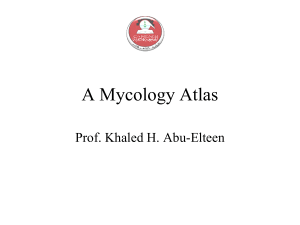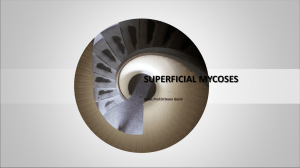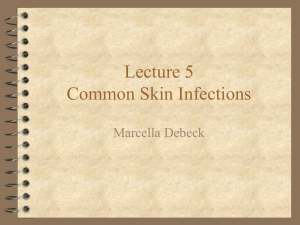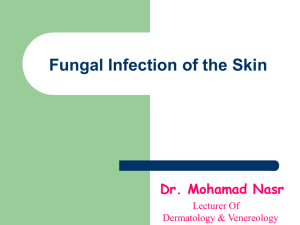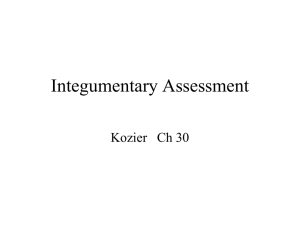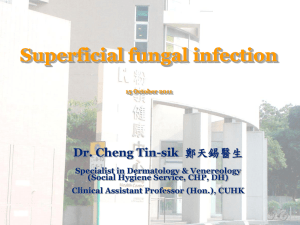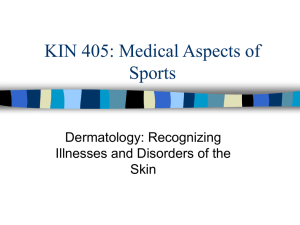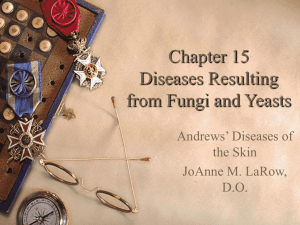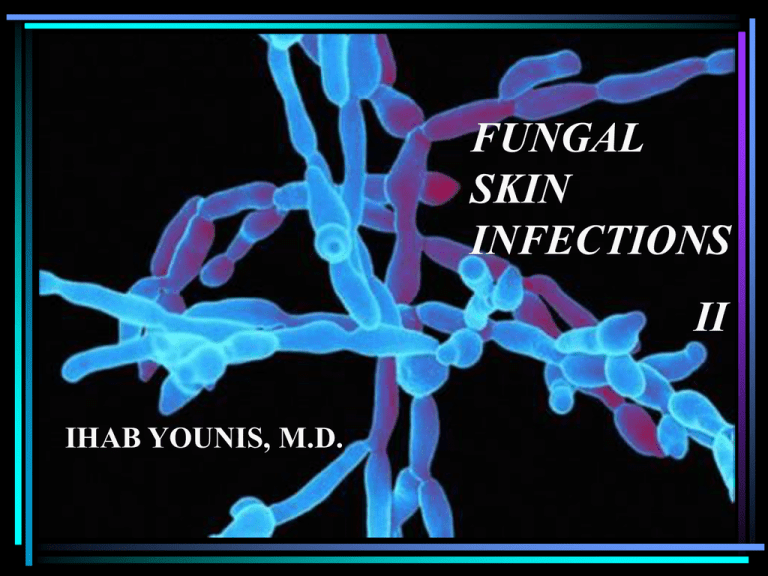
Selling a Product or
Service
FUNGAL
SKIN
INFECTIONS
II
IHAB YOUNIS, M.D.
B .Cutaneous mycoses
• Infections that extend deeper into the
epidermis, as well as hair and nail and
caused by dermatophytes:
– Tinea
– Tinea
– Tinea
– Tinea
– Tinea
– Tinea
capitis
corporis
manus
cruris
pedis
unguium
Tinea capitis
Etymology: L. [caput] head
• Tinea capitis is the most common
pediatric dermatophyte infection
worldwide
• The age predilection is believed to
result from the presence of Malassezia
furfur which is part of normal flora, and
from the fungistatic properties of fatty
acids of short and medium chains in
postpubertal sebum
Hair invasion by dermatophytes
• Ectothrix invasion: Arthroconidia on the
exterior of the hair shaft. The cuticle of the
hair is destroyed and infected hairs fluoresce
under a Wood’s lamp
• Endothrix hair invasion: Arthroconidia within
the hair shaft only. The cuticle of the hair
remains intact and infected hairs do not
fluoresce under a Wood’s lamp
Hair
Ectothrix
Conidia
Hair
Endothrix
Conidia
Types
1-Scaly type:
• Erythematous
papule(s) around the hair
shaft appear initially
• Subsequently, one or
several patches of scaly
alopecia are seen where
the hairs are broken just
above the level of scalp
• The hair looks lusterless
as it is covered with
arthrospores
2-Black dots type:
• It is an endothrix infection,
so hairs become notably
fragile and break easily at
the level of the scalp
• The rest of the infected
follicle looks like
"black dots". Variable
degrees of scaling and
inflamm-ation are seen
3-Kerion :
• Scattered painful pruritic pustular
folliculitis generally associated with
regional lymphadenopathy and even fever
• In about 2-3 %, boggy
nodules studded with
broken hairs and purulent
sticky material "kerion"
appear
• Scarring alopecia develops
subsequently
4-Favus :Etymology: L. honeycomb
• Dense masses of mycelium
and epithelial debris forming
yellowish cup-shaped crusts
called scutula
• The scutulum develops
at the surface of a hair
follicle with the shaft in
the center of the raised
lesion
• Removal of these crusts reveals an
oozing,moist, red base
• After a period of years, atrophy of the
skin occurs leaving a cicatricial
alopecia and scarring
Tinea corporis (circinata)
Etiology
• Affects the glabrous skin (ie, skin
regions except the scalp, groin, palms,
and soles)
• T rubrum is the most common
infectious agent in the world
• May result from contact with infected
humans, animals, or inanimate objects
(eg contact with sports facilities)
Clinically
• Patients can be asymptomatic or
pruritic
• Begins as an erythematous, scaly
plaque that may rapidly worsen
and enlarge
• Central
resolution
causes the
lesion to
be annular
• Scales, crusts, vesicles, and papules often
develop, especially in the advancing border
• Infections due to zoophilic or geophilic
dermatophytes may produce a more
intense
inflammatory
response than
those caused
by anthropophilic
fungi
• Majocchi granuloma manifests as
perifollicular, granulomatous
nodules typically in a
distinct location, which is
the lower two thirds of the
leg in females
• Tinea imbricata (Imbricate=
Ovelapping) is recognized clinically by
its distinct scaly plaques arranged in
concentric rings
Tinea Cruris
Crus=Fold
Etiology
• Transmitted by fomites, such as
contaminated towels or hotel bedroom
sheets
• Autoinoculation occurs in 50 % of cases
from tinea manuum or tinea pedis
• Risk factors for initial infection or
reinfection include wearing tight-fitting
or wet clothing or undergarments
• Tinea cruris is 3 times more common in
men than in women
Clinically
• Patients complain of pruritus and rash
in the groin. A history of previous
episodes of a similar problem usually is
elicited
• Large patches of erythema with central
clearing are centered on the inguinal
creases
• Lesions extend to the thighs , lower
abdomen , pubic area & buttocks
• The penis & scrotum typically are spared
• Scales demarcate sharply the edge
• In acute infections, the rash may be
moist and exudative
• Chronic infections typically are dry with
a papular annular or arciform border
and barely perceptible scale at the
margin
• Chronic infections
modified by the
application of topical
corticosteroids are
more erythematous,
less scaly, and
may have
follicular pustules
• In response to the infection, the active
border has an increased epidermal cell
proliferation with resultant scaling
• This creates a partial defense by way of
shedding the infected skin and leaving
new, healthy skin central to the
advancing lesion
Tinea pedis
Etymology: L. foot
Etiology
• The first report of tinea pedis was in
1908 by Whitfield, who, with
Sabouraud, believed that tinea pedis is
caused by the same organisms that
produce tinea capitis and that it is a
very rare infection !
• T rubrum being the most common
cause worldwide
• Tinea pedis is thought to be the world's
most common dermatophytosis. Rippon
states that 70% of the population will
be infected with tinea pedis at some
time
• Childhood tinea pedis is rare
Risk factors
• A hot, humid, tropical environment
• Prolonged use of occlusive footwear
• Certain activities, such as swimming and
communal bathing, may also increase the risk
of infection
• A defect may be present in the immune
system, such as in cell-mediated immunity,
that predisposes some individuals to tinea
pedis, but this is not certain
Clinical types
1- Interdigital type
2- Chronic hyperkeratotic type(moccasin)
3-Inflammatory/vesicular type
1- Interdigital type:
• The most characteristic type, with erythema,
maceration, fissuring, and scaling, most often
between the fourth
and fifth toes & often
is accompanied by
pruritus
• The dorsal surface of
the foot is usually clear,
but some extension onto the plantar surface
of the foot may occur
2-Chronic hyperkeratotic
type(moccasin)
• Chronic plantar
erythema with slight
scaling to diffuse
hyperkeratosis that
can be asymptomatic
or pruritic
• Both feet are usually
affected
• Typically, the dorsal surface of the foot
is clear, but, in severe cases, the
condition may extend
onto the sides of the
foot
•
•
•
•
3-Inflammatory/vesicular type:
Painful, pruritic vesicles or bullae
Most often on the
instep or anterior
plantar surface
After they rupture,
scaling with
erythema persists
Cellulitis,lymphangitis
and adenopathy can
complicate this type
• Dermatophytid reactions are associated
with vesicular tinea pedis
• They mimic dyshidrosis (pompholyx)
• They develop on the palmar surface of one
or both hands and/or the sides of the
fingers as papules, vesicles, and,
occasionally,
bullae or
pustules may
occur, often
in a symmetrical
fashion
• This is an allergy or hypersensitivity
response to the infection on the foot, and
it contains no fungal elements. The specific
explanation of this phenomenon is still
unclear
• Distinguishing between a dermatophytid
reaction and dyshidrosis can be difficult.
Therefore, a close inspection of the feet is
necessary in patients with vesicular hand
dermatoses
• The dermatophytid reaction resolves when
the tinea pedis infection is treated, and
treatment of the hands with topical
steroids can hasten resolution
Tinea Manuum
Etymology: L. hand
• It is less common than tinea pedis
• Erythema and hyperkeratosis of the
palms and fingers affecting the skin
diffusely is the commonest variety, and
is unilateral in about half
the cases
• The accentuation of the
flexural creases is a
characteristic feature
• Other clinical variants include crescentic,
exfoliating scales, circumscribed, vesicular
patches, discrete, red papular and follicular
scaly patches, and erythematous, scaly
sheets on the dorsal surface of the hand. The
latter forms are more likely to be zoophilic
• When the palms are
infected, the feet are also
commonly infected. A typical
pattern of involvement is
either one hand and both feet or both hands
and one foot
Tinea Barbae
Etiology
• The mechanism that causes tinea barbae is
similar to that of tinea capitis. In both
diseases, hair and hair follicles are invaded by
fungi, producing an inflammatory response
• Currently, tinea barbae is infrequent around
the world
• Tinea barbae was observed more frequently
in the past when infection frequently was
transmitted by barbers who used unsanitary
razors, so it was termed barber's itch
1- Inflammatory deep type (kerion)
• It is the most common clinical presentation
• caused primarily by zoophilic dermatophytes
• Most patients show solitary plaques or
nodules; however, multiple plaques are
relatively common
• Usually localized on the chin, cheeks, or neck,
involvement of the upper lip is rare
• The characteristic lesion is an
inflammatory reddish nodule with
pustules and draining sinuses on the
surface. Hairs are loose or broken, and
depilation is easy
and painless
• Over time, the surface of the indurated
nodule is covered by exudate and crust
• This variety of tinea barbae usually is
associated with generalized symptoms,
such as regional lymphadenopathy,
malaise, and fever
2-Noninflammatory superficial type
• Caused by anthropophilic
dermatophytes
• This variety is less common
and resembles bacterial
folliculitis
• Typically, erythematous patches show
an active border composed of papules,
vesicles, and/or crusts. Hairs are broken
next to the skin
Tinea Unguium and Onychomycosis
• Tinea unguium is clinically defined as a
dermatophyte infection of the nail
plate
• Onychomycosisincludes all infection of
the nail caused by any fungus, including
nondermatophytes and yeasts
Etiology
• It accounts for 20 % of all nail disease
• Approximately 30 percent of patients with
dermatophyte infections on other parts of
their body also have tinea unguium
• The most common dermatophytes
causing tinea unguium worldwide are T.
rubrum, T.
mentagrophytes ,E. floccosum &Candida
Clinically
• Characteristically, infected nails coexist
with normal-appearing nails
• Four types are recognized:
– Distal subungual onychomycosis
– Proximal subungual onychomycosis
– White superficial onychomycosis
– Candidal onychomycosis
Distal subungual onychomycosis
• It is the most common type and
starts by invasion of the stratum
corneum of the hyponychium and
distal nail bed
• Infection moves proximally in the nail
bed and invades the ventral surface
of the nail plate
• Subungual hyperkeratosis results from a
hyperproliferative reaction of the nail
bed in response to the infection
• Invasion of the nail
plate results in a
progressively
dystrophic nail unit
Proximal subungual onychomycosis
• It is the least common variant of
onychomycosis
• It starts by fungal invasion of the
stratum corneum of
the proximal nail fold
and subsequently the
nail plate
White superficial onychomycosis
• Well-delineated opaque "white islands"
on the plate
• Patches coalesce to involve the entire
nail plate. The nail becomes rough, soft
and crumbly
Sporotrichosis
Etiology
• Caused by Sporothrix schenckii
• The organism derives its name from R B
Schenck, who first reported the infection in
1898
• Sporothrix typically exists as a saprophytic
mold on vegetative matter in humid climates
worldwide
• It is a dimorphic fungus i.e. the organism
exhibits mycelial forms at 25°C and a yeast
form at 37°C
• Cutaneous infection often results from a
puncture wound involving thorns or
other plant matter
• Other more unusual reported causes
include squirrel bites and trauma
induced by liposuction
Clinically
1-Lymphocutaneous type
• It is the most common presentation
• Symptoms usually arise within 3 weeks of
injury
• A subcutaneous nodule develops at the site
of inoculation and may ulcerate as the result
of central abscess formation
• Satellite lesions form along the associated
lymphatic chain and lymphadenopathy
subsequently develops
2-Fixed (nonlymphatic) type:
• scaly, acneform, verrucous or ulcerative
nodule that remains localized
• Satellite lesions
and
lymphadenopathy do not
occur in this form
3-Disseminated type
Can result in pyelonephritis, orchitis,
mastitis, arthritis, synovitis, meningitis
or osseous infection
Mycetoma
(Madura foot)
Etiology
• Gill first described the disease in the Madura
district of India in 1842
• In 1813, Pinoy described the mycetoma
produced by actinomycetes (aerobic bacteria)
and classified mycetomas as those produced
by true fungi (eumycetoma) versus those due
to aerobic bacteria (actinomycetoma). Both
types have similar clinical findings
• Causative agents are implanted
subcutaneously, usually after a penetrating
injury
True fungi
(eumycetoma) 40%
Filamentous bacteria
(actinomycetoma) 60%
Dark grain:
• Actinomadura madurae
• Actinomadura pelletieri
• Streptomyces somaliensis
• Nocardia brasiliensis
• Nocardia otitidis-caviarum
• Nocardia asteroides
• Madurella mycetomatis
• Madurella grisea
• Leptosphaeria
senegalensis
• Curvularia lunata
Pale grain:
• Scedospor. apiospermum
• Neotestudina rosatii
• Acremonium spp.
Clinically
• The skin is usually darker and firmer than the
surrounding areas
• Nodules, abscesses, and fistulae draining a
clear viscous or purulent exudate can be seen
• Granules of the microorganisms (sulpher
granules) may occasionally be seen The most
common site is the feet
• In advanced cases, destruction of bone within
an infected area may be almost complete,
and gross deformity may result
Lab diagnosis of fungal
infections
Clinical Material
• Patients with suspected dermatophytosis of
skin:
– any ointments or other local
applications present should first be
removed with alcohol
– Using a blunt scalpel, firmly scrape the
lesion, particularly at the advancing
border. In cases of vesicular tinea
pedis, the tops of any fresh vesicles
should be removed as the fungus is
often plentiful in the roof of the vesicle
• In patients with suspected
dermatophytosis of nails:
– The nail should be pared and scraped
using a blunt scalpel until the
crumbling white degenerating portion
is reached
– Any white keratin debris beneath the
free edge of the nail should also be
collected
• Up to 30% of suspicious material
collected from nail specimens may be
negative by either direct microscopy or
culture
• Repeat collections should always be
considered in cases of suspected
dermatophytosis with negative
laboratory reports
Direct Microscopy
• Skin Scrapings, nail scrapings and
epilated hairs should be examined using
10% KOH
Culture
• Specimens should be inoculated onto
primary isolation media, like
Sabouraud's dextrose agar containing
cycloheximide and incubated at 26-28C
for 4 weeks. The growth of any
dermatophyte is significant
Wood's lamp examination
• It consists of UV light of wavelength
above 365nm filtered through glass
which contains about 9% nickel oxide
• Value: generally of limited usefulness,
because most dermatophytes currently
seen do not fluoresce
• May have value in the following
situations:
– For diagnosing a brown, scaly rash in the
scrotum or axilla: erythrasma fluoresces a
brilliant coral red, whereas tinea cruris or
cutaneous candidal infections do not
fluoresce
– For diagnosing tinea versicolor, which
fluoresces pale yellow to white
– For diagnosing tinea capitis caused by
two zoophilic Microsporum species that
fluoresce blue-green
Histopathology
PAS stain: Spores & hyphae in the keratin
Tinea versico;or:
Spaghetti & meat
balls

